You're using an outdated browser. Please upgrade to a modern browser for the best experience.
Please note this is a comparison between Version 1 by Abiodun Kolawole Oyetunji and Version 2 by Dean Liu.
With the COVID-19 pandemic underway, there were challenges with STEM (Science Technology Engineering and Mathematics) modules and other teaching contents due to practical laboratory sessions and workshops required. Thus, the need to understand teaching style, online learning and its role in promoting a variety of desirable academic outcomes, such as increased achievement and decreased dropout rates, as well as various well-being and life outcomes, has advanced significantly.
- teaching
- higher education academy (HEA)
- learning
- COVID-19
1. Introduction
Since COVID-19 first appeared, e-learning has become more common [1][2][3][4][5][6][7][1,2,3,4,5,6,7]. In order to understand disparities in e-learners’ self-efficacy, satisfaction, motivation, attitude, and performance globally, an annotated bibliography on related studies that looks at these variables is necessary. Many educational institutions have been forced to close due to the sudden COVID-19 outbreak, and many students have been forced to stay at home and take online courses [8][9][10][11][12][13][14][8,9,10,11,12,13,14]. With the COVID-19 epidemic underway, there were challenges with STEM (Science Technology Engineering and Mathematics) modules due to practical laboratory sessions and workshops required [15][16][17][18][19][20][15,16,17,18,19,20]. Without regard to their physical location, e-mentoring enables teachers to communicate with students via email, online chat, and bulletin boards. As a result, when students feel engaged in an activity, they are better able to develop their own knowledge. The need to have better teaching styles, teaching tools, and effective teachers globally that will continue to foster quality education is the bedrock of any Higher Education Academy (HEA). To ensure that learners can benefit from mentoring, it is crucial to comprehend learners’ attitudes regarding online mentoring. Feedback can come from both the mentors and the students. Reflecting on student feedback and the use of e-study as digital tools for teaching, such as e-boards, projectors, public address systems, and state-of-the-art lecture e-kits, are highly emphasized in Higher Education Institutions (HEI). Having these teaching aids, the student can download teaching notes as electronic files or use their mobile phones to record the lecture notes so they can be revised as their own files later.
One of the primary challenges that educational institutions and libraries face is the availability of annotated bibliographies that cover teaching methods in HEAs. Annotated bibliographies could be used to identify knowledge gaps, such as understanding student engagements by using studies on the lack of participation against high-level participation of students. However, some other annotated bibliographies present different levels of course-based teaching in English [21][22][23][24][25][26][27][21,22,23,24,25,26,27], but there is a gap for general teaching in HEAs. Also, there are other annotated bibliographies on different fields ranging from areas of teaching [28], virtual exchange [29], STEM teacher education [30][31][30,31], gender bias [32], digital library [33], plagiarism in engineering [34], online learning [35], technical education career [36], curriculum design [37], engaged learning [38], group works [39], business models [40][41][40,41], economics of education [42], scheduling [43], forecasting [44], algorithms [45], distance learning [46][47][46,47], sociology [48][49][48,49], greedy randomized adaptive search procedure (GRASP) optimisation [50], geological lineation [51], to health [52]. However, there is a need to sustain the quality of teaching in HEAs. To address this challenge, the authors outlined strategies for communicating the purpose and value of the discussion, setting clear expectations for responses, and designing a structure for the discussion. Another aspect of teaching is online learning, which has recently increased globally due to the COVID-19 pandemic [20][52][20,52]. Higher education institutions started using the internet as an alternate learning environment in addition to traditional teaching and learning methods in front of classes about 30 years ago [53]. For students and educators that actively participate in online courses, this type of environment continues to provide significant obstacles, thus, there is a need to include these themes in an annotated bibliography. Some studies reviewing best practices adapting to the COVID-19 pandemic in teaching also presented some lessons learnt [53][54][55][56][57][53,54,55,56,57]. The pandemic has availed reusearchers to have new perspectives, and lessons have been learnt by institutions as well as their teacher educators during COVID-19 [58][59][60][61][62][58,59,60,61,62]. Despite the enormous hurdles during the pandemic, there are positives that will endure over the long term. Due to COVID-19, theour entire educational system and organisational structure had to transition to fully remote communication and online learning [63][64][65][66][67][63,64,65,66,67]. This means that all the teachers, instructors, and students have to understand that technological improvements need to urgently and significantly help address theour sustainability challenges given how swiftly they have spread around the world. It is pertinent that the teachers understand student engagement and determine how learners feel about teaching. This could be adaptable, from having blended learning, online mentoring, to group learning studies. However, the latter is covered in another publication [67] of this annotated biography on teaching in HEAs.
2. Scientific Review and Scientometric Analysis on the Annotated Bibliography
TIn this section, the scientific review and scientometric analysis were conducted for the annotated bibliography on teaching in higher education academies based on the research themes. TIn this study, the research trends were investigated from the publication history, the publication classification, the subject area, the publication by country, journal range, the author keywords, and the publication by affiliations. To understand the research pattern on teaching in HEAs, data were retrieved from Scopus and are presented in the findings in Figure 13, Figure 24, Figure 35, Figure 46, Figure 57, Figure 68, Figure 79 and Figure 810.
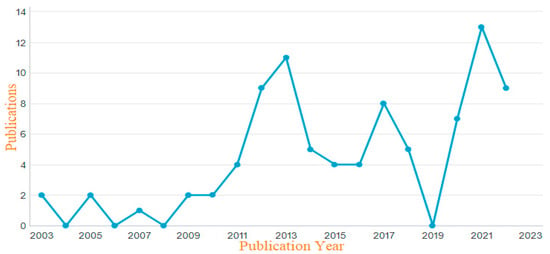
Figure 13. Results of publication records for the research on “teaching AND higher AND education AND academy AND online AND learning OR COVID-19” (data retrieved from Scopus database on 22 August 2022).

Figure 24. Results of publications by subject area for the research on “teaching AND higher AND education AND academy AND online AND learning OR COVID-19” (data retrieved from Scopus database on 22 August 2022).
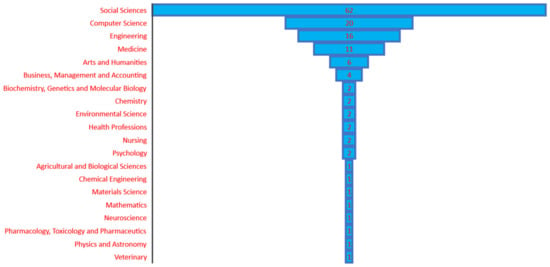
Figure 35. Results of publications by classification (or type) for the research on “teaching AND higher AND education AND academy AND online AND learning OR COVID-19” (data retrieved from Scopus database on 22 August 2022).
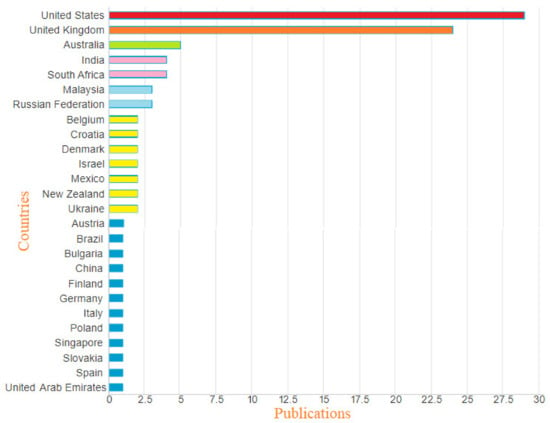
Figure 46. Results of publications by countries for the research on “teaching AND higher AND education AND academy AND online AND learning OR COVID-19” (data retrieved from Scopus database on 22 August 2022).
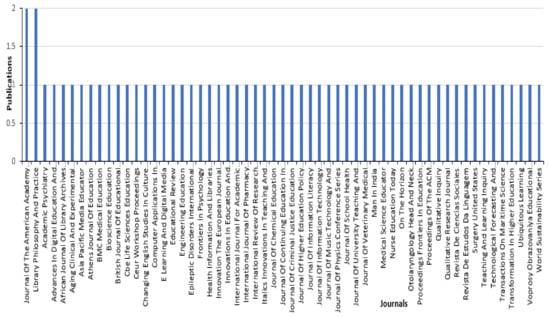
Figure 57. Results showing range of journal publications for the research on “teaching AND higher AND education AND academy AND online AND learning OR COVID-19” (data retrieved from Scopus database on 22 August 2022). See details in Supplementary Materials.
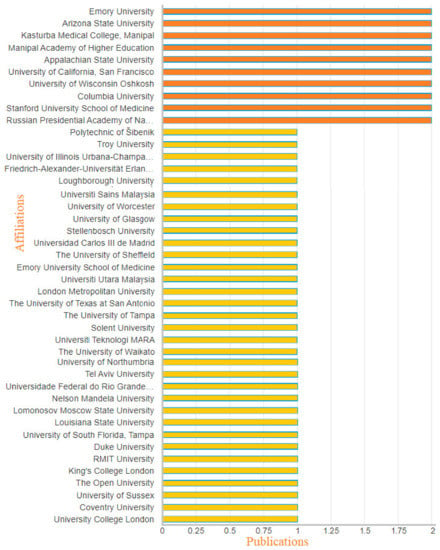
Figure 68. Results of publications by affiliation for the research on “teaching AND higher AND education AND academy AND online AND learning OR COVID-19” (data retrieved from Scopus database on 22 August 2022).

Figure 79. Word cloud for the author keywords research on “teaching AND higher AND education AND academy AND online AND learning OR COVID-19” using Voyant tools.

Figure 810.
Results of relative frequency and trend from the most frequent author keywords generated using Voyant tools.
From Figure 13, it was observed that there were different shifts in this subject area as seen in the pattern of the publications from 2003 to 2022. The highest number of publications was 13 publications in 2021, followed by 11 publications in 2013, followed by 9 publications in 2012 and mid-2022, followed by 8 publications in 2017, followed by 7 publications in 2020. The highest occurrence by year was two publications, which appeared four times in 2003, 2005, 2009, and 2010. The second highest occurrence by year was four publications, which appeared three times in 2010, 2013, 2020, and 2021. It was observed that different global occurrences could have affected the research trends noticed in this subject area, such as the 2008 global economic recession, the 2016 drop in oil price, and the COVID-19 pandemic that hit the global world in 2020. It was observed that the publications did not increase around these times, but further evidence is required to support this pattern. With the increase in online learning, publications rose from 7 publications in 2020 to 13 publications in 2021, showing a sharp increase of 65% between both years.
From Figure 24, it was observed that the publications from the search were mostly journal papers or articles (55%), which covered 48 publications, followed by conference papers (30%), which covered 26 publications. It was then followed by book chapters (9%), which covered 8 publications, followed by reviews (2%) which covered 2 publications. There was also one publication that was a full book, one editorial, one erratum, and one conference review paper, which were each the least prevalent (1%). This shows that most publications on this subject area were available as articles or journal papers.
From Figure 35, it was observed that the subject area from the search with the highest publications was Social Sciences (45%) with 62 publications, followed by Computer Science (14%) with 20 publications, then by Engineering (12%) with 16 publications. It was followed by Medicine (8%) with 11 publications, followed by Arts and Humanities (4%) with 6 publications, followed by Business, Management, and Accounting (3%) with 4 publications. The next set each produced two publications—Health professions (1%), Chemistry (1%) Environmental Science (1%), Nursing (1%), and Psychology (1%)—followed by the last set, which produced one publication each—Materials Science, Neuroscience, Pharmacology, Mathematics, Physics, and Astronomy.
From Figure 46, it was observed that the country with the highest publications is the United States of America (U.S.A.) with 29 publications, followed by the United Kingdom (U.K.) with 24 publications. The next pair of publications was much lower as Australia had 5 publications, followed by the pair whereby each nation had four publications, India and South Africa, followed by the next set of publications whereby each nation had three publications, Malaysia and the Russian Federation. The next set of publications whereby each nation had two publications included Belgium, Croatia, Denmark, Israel, Mexico, New Zealand, and Ukraine. The smallest set of publications by country had one publication each (Austria, Brazil, Bulgaria, China, Finland, Germany, Italy, Poland, Singapore, Slovakia, Spain, and United Arab Emirates). However, there were five publications that were undefined from the Scopus data retrieved from this search. It was also observed that the U.S.A. and the U.K., which are both developed countries that make significant investments in educational research, are the study’s top two countries.
Another aspect of the research trend is seen from the publications where these articles were published as given in Figure 57. Also, the range of publications in this subject area is spread across different areas, and the highest number of publications (two articles) in this area was published in the journals called “Journal of the American Academy of Dermatology” and “Library Philosophy and Practice”. The second set of publications had one article each, which include: “Academic Psychiatry”, “Advances in Digital Education and Lifelong Learning”, “African Journal of Library Archives and Information Science”, “Aging Clinical and Experimental Research”, “Asia Pacific Media Educator”, “Athens Journal of Education”, “BMC Medical Education”, “Bioscience Education”, “British Journal of Educational Technology”, “Cbe Life Sciences Education”, “Ceur Workshop Proceedings”, “Changing English Studies in Culture and Education”, “Computer Applications in Engineering Education”, “E-Learning and Digital Media”, “Educational Review”, “Engineering Education”, “Epileptic Disorders International Epilepsy Journal with Videotape”, “Frontiers in Psychology”, “Health Information and Libraries Journal”, “Innovation inthe European Journal of Social Science Research”, “Innovations in Education and Teaching International”, “International Journal for Academic Development”, “International Journal of Pharmacy Practice”, “International Review of Research in Open and Distance Learning”, “Italics Innovations in Teaching and Learning in Information and Computer Sciences”, “Journal of Chemical Education”, “Journal of Continuing Education in Nursing”, Journal of Criminal Justice Education”, “Journal of Higher Education Policy and Management”, Journal of Information Literacy”, “Journal of Information Technology Education Research”, “Journal of Music Technology and Education”, “Journal of Physics Conference Series”, “Journal of School Health”, “Journal of University Teaching and Learning Practice”, “Journal of Veterinary Medical Education”, “Man in India”, “Medical Science Educator”, “Nurse Education Today”, “On the Horizon”, “Otolaryngology Head and Neck Surgery United States”, “Proceedings Frontiers in Education Conference”, “Proceedings of the ACM Conference on Computer Supported Cooperative Work”, “Qualitative Inquiry”, “Qualitative Research Journal”, “Revista De Ciencias Sociales”, “Revista De Estudos Da Linguagem”, “Surgery United States”, “Teaching and Learning Inquiry”, “Technological Forecasting and Social Change”, “Transactions on Maritime Science”, “Transformation in Higher Education”, “Ubiquitous Learning”, “Voprosy Obrazovaniya Educational Studies Moscow”, and “World Sustainability Series”.
The next aspect looked at was the results of publications by affiliation for the research on “teaching AND higher AND education AND academy AND online AND learning OR COVID-19”, as represented in Figure 68. It can be observed that the highest amount of publications by affiliation was two publications. These affiliations were “Emory University”, “Arizona State University”, “Katurba Medical College”, “Manipal Academy of Higher Education”, “Appalachian State University”, “University of California”, “University of Wisconsin”, “Columbia University”, “Stanford University”, and “Russian Presidential Academy of Economy and Public Administration”. It was followed by a set of affiliations that produced one publication, which included “University of Illinois”, “Loughborough University”, “University of Northumbria”, “University of Worchester”, “Tel Aviv University”, “University College London”, “Trop University”, “University of Sussex”, “Duke University”, “Louisiana State University”, “Solent University”, “Coventry University”, “Kings College London”, “The Open University”, “University of Glasgow”, “University of Tampa”, “University of Sheffield”, and “Nelson Mandela University”. These affiliations are from different locations, which shows that research on education with an emphasis on teaching in higher education academies is being conducted globally. However, the rates of production are not very high, which could imply low funding in this research area.
The last parameter looked at is the author keywords from the search using data retrieved from Scopus. It was identified that the most frequent keywords in the corpus for the word cloud using Voyant tools were “learning (47)”; “education (44)”; “online (27)”; “teaching (20)”; “higher (15)”. This can be identified in the word cloud depicted in Figure 79, which was developed using 808 words and 400 unique word forms. From the cirrus on Voyant tools, the word cloud was generated and identified to have a vocabulary density of 0.495, a readability index of 30.999, and an average word per sentence of 808.0. Using the most frequent words, a trend was identified as depicted in Figure 810, showing that learning is the keyword with the highest relative frequency.
